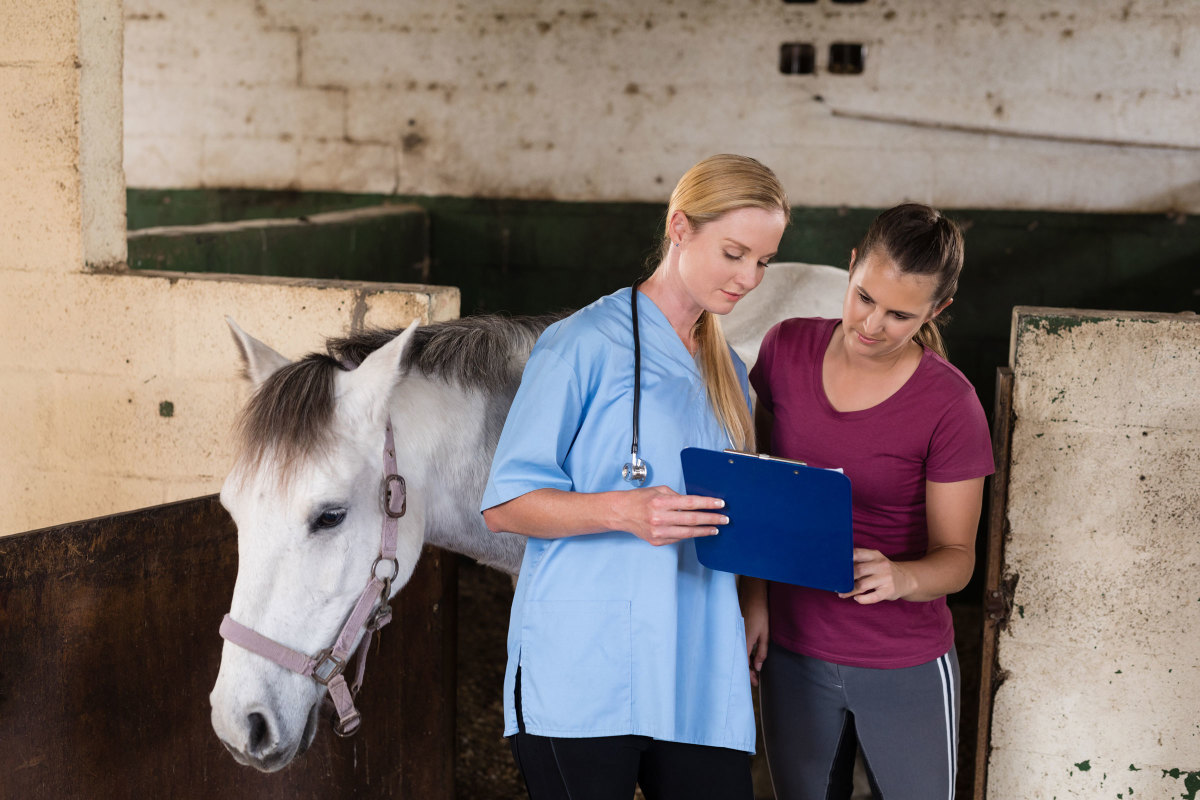
You’ve finished four years of undergrad, and you’re almost finished with your final rotations before heading off to an internship or to your first year as an associate veterinarian. You’re leaving behind friends, mentors and a comfortable routine.
The education you’ve received has given you the practical skills needed to handle just about every scenario you’ll encounter. You have knowledge of the latest treatment protocols for common conditions. And you’ll be nervous—perhaps you’ll even question your abilities.
“In the classroom you are very prepared, and you know what you are going to be tested for,” said Kianna Spencer, DVM, who at this writing was nearing completion of her internship at Pine Bush Equine. “In the real world, you get to the appointment without knowing what you are going to encounter.”
But it’s not the technical skills that you’ll find the most challenging, it’s the soft skills—the client relationships—that will shake your confidence.
“This is a people business,” said Mike Pownall, DVM, MBA, who is part owner of McKee-Pownall Equine Service and a partner with Oculus Insights (a practice management consulting firm). “You still have to have a love for the horse, but you’re going to struggle in practice if you think it’s all about the horse and its care.”
Gaining a client’s trust and developing long-term relationships takes time. It also requires solid communication skills for navigating difficult conversations. Here are four tips to help you prepare for your first position.
1. Sharpen the Soft Skills
Many veterinarians go right from high school to undergraduate studies, continuing straight to veterinary school without taking time off or working in another career. For some, that means they have had little experience reading facial expressions, interpreting body language or directing complicated discussions.
It might sound clichéd, but clients are more likely to remember how you made them feel than they are to recall a mistake. It might take a recent graduate longer to tube a horse or complete a dental exam, but if you have an established rapport with the client, he or she won’t remember those details.
Pownall said that euthanasia is often the moment clients appreciate the most when it is done well. “Showing empathy and taking the time to answer their questions and provide all of their options makes the client feel like their concerns are being heard, and that goes much farther in building a relationship than using the newest technology to treat a horse,” he said.
This type of learning happens on the job.
Observing seasoned veterinarians’ interactions with clients is one way to glean effective communication strategies. Some of this develops through pre-visit preparation.
“I try to be prepared with the history of the patient and owner, as well as working alongside the vets they have been working with to build that relationship,” Spencer said.
2. Manage Expectations
Interacting with clients might be the most overwhelming aspect of the job for new associates. Learning how to manage a client’s expectations can go a long way toward building lasting relationships. It’s important to recognize that all clients have some level of expectation related to the outcome of an appointment.
Ask the client what he or she expects in the short-term and the long-term if the horse has an injury or ongoing illness. Listen to what the client says is most important to him or her. That will help you determine how to respond and how to interpret the prognosis. Understanding where the client is coming from provides clues as to how to direct a dialogue so that the client is confident with what’s been done, even if the outcome isn’t the desired one.
“Sometimes you also have to be humble and ask for help when you don’t know what you are dealing with,” Spencer said. At the end of the day, the client will appreciate that you’ve put his or her horse’s well-being ahead of your ego.
Develop a network of veterinarians you can trust and turn to in these situations. It might be a mentor from college, a colleague you’ve met through continuing education programs or online communities designed specifically for veterinarians to communicate.
The hardest realization for new veterinarians to accept is that a client’s perception becomes his or her reality. Even when a diagnosis or treatment protocol is textbook-perfect and something goes wrong, there can be the perception by the client that the veterinarian should have done something differently.
Having good communication skills to explain each step of the diagnosis and treatment and to manage expectations can help avoid this problem.
3. Slow Down and Enjoy the Moment
Society has portrayed younger generations as having a lackluster work ethic. Millennials are sometimes described as being less motivated and less committed than their older peers.
Pownall disputes this stereotype—in his experience, newly minted veterinarians are so motivated that they are putting too much pressure on themselves. “Don’t put pressure on yourself to be outstanding right away,” he said. “We all make mistakes. That’s why it’s called veterinary practice.”
There will be bumps in the road. Instead of panicking and rushing through, go back to the basics of what you do know. Every veterinarian knows how to give a physical exam and take a horse’s vital signs. Start there and begin problem solving. Turn to your trusted network of mentors to provide guidance when needed.
Slowing down applies as much to a veterinarian’s personal life as it does to his or her professional work. Work-life balance to keep the veterinarian healthy is as important as keeping horses healthy.
Veterinarians are vulnerable to burnout and suicide. Pownall encouraged recent graduates to prioritize their well-being. “These issues aren’t talked about enough, but they are as important as professional development,” he said. “Make sure you find resources for mental health and self-care when needed.”
4. Build Relationships
Developing trust with clients happens over time. It starts with good communication skills and by demonstrating your interest in caring for their horses. Even the seemingly inconsequential actions go a long way toward building client relationships.
“Taking the time to pat the horse on the neck and ask the owner a few general questions about the horse demonstrates how important the animal is to you,” Pownall said.
Finding a shared connection—either a compliment about a horse in the barn, a mutual friend or a shared interest in specific bloodlines, etc.—can support meaningful, long-term relationships.
Last fall, Spencer visited a farm for the first time to work up a colic case. After the initial exam, she and the owners were chatting when a pretty-headed Quarter Horse stallion caught her eye.
She asked about the horse, and the owners revealed that they had purchased him as a weanling 16 years ago. They bought him from a farm several hours away where Spencer’s significant other once worked. The clients knew the horse’s sire, but couldn’t remember the dam.
Later that evening, Spencer asked her significant other about the horse and which mare the stallion could have been out of. “He said, ‘You know the horse’s dam very well. In fact, I’m looking at her right now—she’s sitting in my field!’” she recalled. “As it turned out, the horse was out of my own broodmare. I called the clients the next morning to tell them the coincidence, and we have been great friends ever since.”
Take-Home Message
Starting any new career in any profession is nerve wracking. Recent veterinary graduates might feel this pressure more than other professions because a horse’s well-being is at stake. It’s easy to get wrapped up in the stress of it all.
“Take a step back every now and then and realize that you are living the dream. You made it!” said Spencer. “Veterinary medicine can be extremely demanding and stressful, but there are very few professions as rewarding.”
Being resourceful and taking advantage of every learning opportunity that comes along can add confidence and experience. Today’s world revolves around instant gratification. Remember that successful professionals build their careers over years.
“Our refuge is the connection with the horse,” Pownall said. “Take a breather to enjoy what miraculous animals the horses are.”
SIDEBAR
Tips for Practices Hiring New Veterinarians
Mike Pownall, DVM, MBA, a veterinarian and practice management consultant, hosts the American Association of Equine Practitioners (AAEP) Practice Life podcast. His September 2018 episode offered advice for new associates.
Two recent veterinary graduates, Jenna Donaldson of Rhinebeck Equine LLC and Zack Loppnow of Anoka Equine Veterinary Services, and seasoned practitioner Ernie Martinez of Hagyard Equine Medical Institute, dispensed advice that practice owners can use to help new associates feel welcome and have successful starts to their careers.
Present the new associate to the client in a positive light. Donaldson praised her colleagues for talking up the skills she brought to the table as a recent graduate. When experienced veterinarians take time to highlight the experience and talents that the newer individual brings to the table, clients are more likely to trust that person.
Check in periodically. Loppnow described recent graduates as intensely motivated to succeed. Sometimes that can be done to a fault when they are striving to be perfect and exude confidence. Regular check-ins by practice owners should happen throughout the year. Simply asking “How are you doing?” opens the door for that new veterinarian to ask questions or discuss any challenges.
“We can hide failures and self-conscious moments, because we want to present a confident front,” Loppnow said. “New graduates need an opportunity to check in and see how things are going from the owner’s viewpoint. It doesn’t have to be a formal meeting.”
Involve interns in client discussions. Martinez encouraged seasoned doctors to include interns in the process of how he/she explains treatment options and outcomes to the client. If the conversation happens over the phone, use a speaker phone so the intern can hear the client’s response and questions.
“That gives interns experience to fall back on the next time they have a similar case,” he said.









